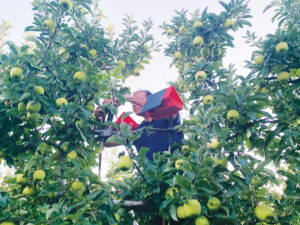
May/June 2023
Pest management and tech
FlightSensor monitors insects through AI
For decades, limited pest monitoring options have been available to growers prior to taking corrective action. Sticky traps are a time-consuming and inaccurate method while broadcast sprays of selected pesticides and insecticides can be inconsistent and can also harm beneficial bugs that pollinate more than 70% of the global crop supply, said Leslie Hickle, CEO and co-founder of FarmSense Inc.
The FlightSensor from the Riverside, California, ag tech startup company monitors insects through AI and machine learning algorithms. FlightSensor is designed to remove uncertainty from pest management, Hickle said. The technology is being studied in cruciferous vegetables, stone fruit, winegrapes and nuts.
The sensor sends insect signals and environmental information from fields to the cloud. The algorithm classifies and counts insects before sharing data to a grower’s dashboard, allowing mobile crop status viewing.
No need for sticky cards
“FarmSense’s FlightSensor is a novel technology not dependent on sticky cards, which are the bane of entomologists,” Hickle said. “We had developed so many economic models for predicting pest impact, but no way of populating them with in-field real-time data.
“Sticky cards were only checked every 7 to 10 days because they were just too labor intensive,” she said. “We could now understand what was happening in the field and each pest had a unique fingerprint, so we could monitor multiple pests and the time they were active.”
Though FlightSensor can be customized for nearly any crop, FarmSense’s initial focus was on nut farming. This year, the company plans to send 1,000 sensors to field trials that target navel orange worm in nut crops.
“The insect we have the most Flightsensor information is the navel orange worm, a major pest in walnut, pistachio and almonds,” said Tracy Ellis, a FarmSense entomologist. “Farmsense will be placing 1,000 sensors into the hands of PCAs (pest control advisors) and growers this season who can trial the device for free this year.” The sensors were delayed in manufacturing, she said.
The U.S. Department of Agriculture’s Charles Burkes published a paper comparing different Flightsensor attractants and lures. Additionally, several other growers have field tested in one of the nut crops over the past several years with positive feedback and an continued interest in seeing the device move forward into commercialization so they can purchase it for their own use, Ellis said.
Trial placement of sensors

FarmSense attended the 2022 annual almond and the 2023 annual pistachio conferences to network for trial placement of our sensors. Ellis said she is sorting through the leads so the sensors can be distributed throughout the Sacramento and San Joaquin valleys in a variety of locations and circumstances.
To expand knowledge on how sensors can be used in applications such as area wide suppression and various combinations of pests in nut and fruits, two grants have been submitted for continued research collaborations with the USDA and University of California Cooperative Extension Ellis said.
“The FlightSensor’s strengths are currently designed around medium- sized moths which have a pheromone lure,” Ellis said. “The sensor technology has many applications, however.”
Luring insects
An electronic optical curtain inside FlightSensor’s plastic housing lures insects and triggers signals. Different species are assigned unique fingerprints. Non invasive sensors record temperature and humidity, the main factors in pest population development. The data logging also allows for building of historical records.
“Farmers can use this information to determine if they are dealing with beneficial or invasive species and take strategic action before lasting damage is done to crops,” Hickle said. “The result is better crop yield, lower pesticide use, reduced environmental damage and less risk of insect resistance.”

FarmSense and its insect monitoring technology originated from University of California-Riverside computer scientists Shailendra Singh, FarmSense’s chief technology officer, and Eamonn Keogh, a data mining expert who pioneered computational entomology. They met entomologist Hickle and founded the company.
“There’s a discrepancy in valuing pest control because it’s been traditionally a very small input cost to the grower compared to all the other costs to produce a crop,” Hickle said. “Yet, if you don’t treat, you can lose the crop. Timing isn’t as important with broad spectrum pesticides, so many of the sprays are still scheduled and used as insurance. We understand that it will be a few years before our models eliminate the risk of using less toxic and more targeted treatments.”
Hickle said data is providing the next evolution in agriculture, and that “it’s the next age: Agrarian, Industrial, Information.”









